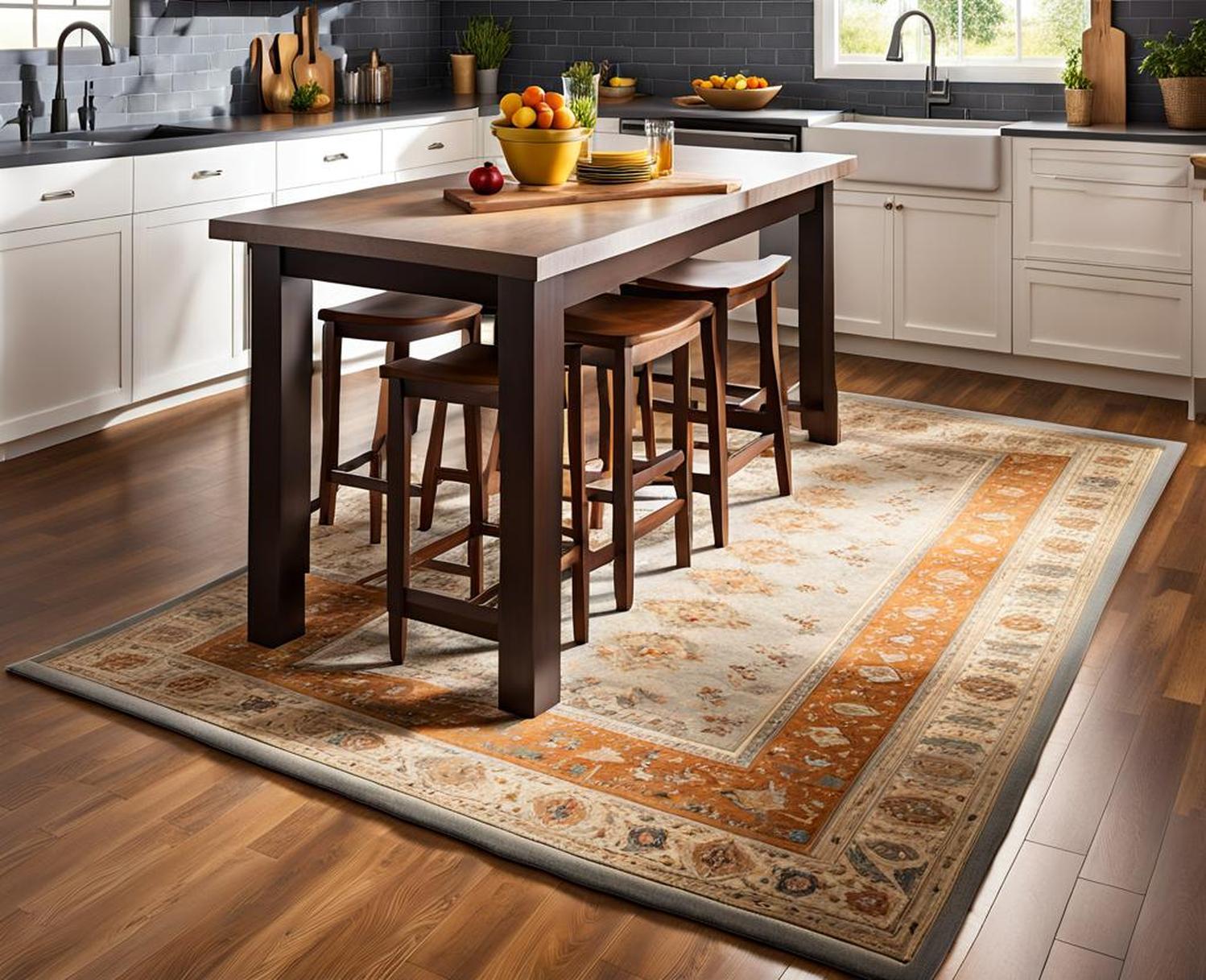Choosing the perfect rug for under your kitchen table can be a tricky endeavor. You want something stylish yet practical that can handle the hustle and bustle of mealtimes. After much trial and error with various rugs that ended up stained, frayed or bunched up, I finally discovered the ideal rug for anchoring my kitchen space.
From the best materials to the right size and shape, read on for tips to find the only rug that truly belongs under your kitchen table.
Wool is the Gold Standard for Kitchen Rugs
If you want a rug that can hold up to years of mealtime messes, spills and constant foot traffic, wool is hands down the best material. Wool rugs are naturally stain and moisture resistant. Liquids like wine, juice or oil roll right off wool, allowing the rug to be easily spot cleaned.
Wool also retains its appearance extremely well, resisting crushing and floor impressions. A high quality wool rug will likely be the last one you ever need to purchase for your kitchen.
Other Good Options for Kitchen Rugs
While wool reigns supreme, other materials can also work well under a kitchen table:

- Cotton – Absorbs spills quickly but shows dirt easily.
- Jute – Has nice texture but stains permanently.
- Polypropylene – Resists spills but lacks richness.
Cotton rugs are comfortable underfoot and absorbent, making them good for quick mop-ups. But cotton rug fibers hold onto stains, requiring frequent laundering. Jute makes a nice natural fiber choice, though any spills become permanent stains.
Size Matters – Get a Big Enough Rug
A common mistake is buying a kitchen rug that’s too small. Size greatly impacts how well your rug anchors the space.
The rug should extend at least 24 inches beyond the outer edges of the table on all sides. An 8×10 or 9×12 size rug usually provides adequate coverage.
Allow Enough Space Around the Table
Having enough rug surrounding the table serves several purposes:
- Lets diners easily pull out and push in chairs without catching.
- Protects more of your floors from spills and chair scratches.
- Visually defines the dining space.
Getting a rug too small for the area is a waste of money. Go for the largest size that reasonably fits without touching walls or cabinets.
Simple Patterns Help Hide Soiling
While solid colored rugs look sleek initially, they show every dust bunny and spill. Instead, look for subtle patterns like checkerboard or tone-on-tone distressed designs.
Patterns artfully disguise grime and wear. But steer clear of busy, intricate patterns which look dirty fast. Aim for simple, cleanable patterns.
Rugs with Textured Designs Work Best
Rugs with textured designs do a better job masking messes than flat pile rugs. Choose rugs with:
- Thick woven textures
- Looped or braided piles
- Nubby berber patterns
Three-dimensional surfaces show less dirt. Casual textures and seagrass-style weaves also better hide chair scratches and rug impressions.
Invest in a Durable & Easy-Care Rug
Kitchen rugs take a real beating from chair legs scooting back and forth, people walking over them, cleaning chemicals, pet accidents, and kids playing. Prioritize durability in your rug’s material and construction.
Also, consider maintenance. Look for rug materials and backings that allow for easy, regular cleaning. Rugs that can be occasionally machine washed are a major plus.
Tough Fibers Stand Up to Heavy Use
The strongest rug fibers include:
- Wool
- Polypropylene
- Polyester
- Seagrass
- Jute
Sturdy synthetic or natural fibers resist crushing and retain their appearance better. Delicate silk or viscose rugs won’t fare well.
Non-Slip Backing Prevents Hazard
Cushiony rug backings grip floors to stop slipping. Look for:
- Latex backing
- Vinyl backing
- Rubber backing
Non-slip backings prevent falls and make rugs lie flat. Mesh backings won’t grip adequately. Using a non-slip rug pad provides extra traction.
Common Mistakes to Avoid
I made all these mistakes during my quest for the perfect kitchen rug. Learn from them!
- Don’t use a small size – it will constantly move around under the table.
- Avoid white or light colors – they show every speck of dirt.
- Don’t use rugs with long shaggy piles that snag heels.
- Skip poor quality rugs that flatten out or degrade quickly.
Buying the wrong kitchen rug just wastes money. Measure properly and select a style suited for high-traffic areas.
Rug Ideas for Stylish, Durable Performance
Here are some of my favorite rug options that check all the boxes for durability, easy care, and stylish good looks under a kitchen table:
Modern Zigzag Patterned Wool Rug
Zigzags cleverly hide dirt while jazzing up the room with bold geometric style. The wool material provides natural stain resistance.
Vintage Persian Style Floral Rug
These floral rugs work well when you want a traditional, ornate style. The distressed coloring disguises imperfections.
Braided Jute Herringbone Pattern Rug
Jute has a wonderful natural texture, though the light tan color requires more vacuuming. The herringbone pattern intercepts crumbs.
Solid Oversized Wool Rug
Can’t beat wool for durability and cleanability. An extra large size properly anchors the space.
Colorful Geometric Cotton Rug
The geometric shapes and multi color design hides dirt well. Tightly woven cotton makes it easy to clean.
Choosing the right kitchen rug involves considering size, material, color and pattern. But there are durable, stylish rugs out there that will perform beautifully under your kitchen table for years to come. Measure carefully, read rug details, and don’t settle for a size too small or made of flimsy material. Investing in the proper kitchen rug saves time, money and frustration down the road. With a little know-how, you can find the rug you love that will stand up to the rigors of high-traffic kitchen life.
